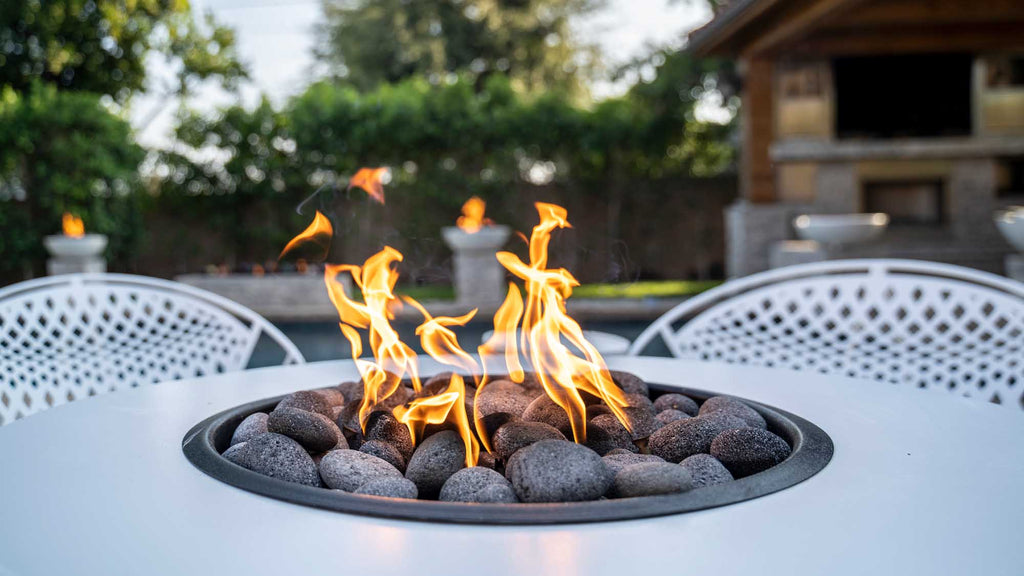An Overview of Fire Pit Media
One essential aspect of a fire table is the fire media - the material that fills the burner pan and enhances the visual appeal of the flames. The right fire media can completely transform the look of your fire table, adding a unique touch to your outdoor décor. There are several fire media options available, such as lava rocks, fire glass, and ceramic logs, each with its own advantages and drawbacks.
Here Are The Pros and Cons of Various Fire Media Options
Here we delve into the pros and cons of various fire media options to help you determine the best choice for your fire table. By understanding the benefits and limitations of each fire media type, you can make an informed decision that caters to your aesthetic preferences, budget, and maintenance needs.
1. Lava Rocks
Lava rocks are a popular fire media choice due to their natural, rugged appearance and excellent heat retention properties. They are formed when volcanic magma solidifies and are available in different shapes, sizes, and colors.
Pros
Heat retention: Lava rocks can hold and radiate heat effectively, providing warmth to your outdoor space.
Cost-effectiveness: Lava rocks are generally more affordable than other fire media options, making them an excellent choice for budget-conscious consumers.
Natural appearance: The organic texture and earthy colors of lava rocks blend seamlessly with outdoor settings, creating a harmonious and inviting ambiance.
Cons
Porous nature: Lava rocks can accumulate dirt and debris, requiring regular cleaning to maintain their appearance.
Potential for sharp edges: Some lava rocks may have sharp edges, posing a risk of injury if not handled with care.
Limited color options: Lava rocks are typically available in natural hues, which may not suit everyone's design preferences.
2. Fire Glass
Fire glass is a dazzling fire media option, made from tempered glass that has been tumbled to remove sharp edges. The reflective properties of fire glass create a captivating display, while the wide range of colors and shapes allows for endless customization.
Pros
Aesthetic appeal: The shimmering reflections of fire glass create a mesmerizing visual effect, enhancing the ambiance of your fire table.
Versatility: Fire glass is available in various colors, shapes, and sizes, allowing you to customize the appearance of your fire table to suit your design preferences.
Low maintenance: Fire glass is non-porous and does not produce soot or ash, making it an easy-to-clean option for your fire table.
Cons
Cost: Fire glass is generally more expensive than other fire media options, which may be a concern for those on a tight budget.
Heat retention: Fire glass does not retain heat as well as lava rocks, which could be a consideration for those seeking maximum warmth from their fire table.
Safety concerns: Fire glass can become hot to the touch, posing a burn risk if not handled carefully.
3. Ceramic Logs
Ceramic logs are designed to mimic the appearance of traditional wood fires while offering the convenience of gas-powered flames. They are made from heat-resistant materials and come in various sizes and styles to fit your fire table.
Pros
Realistic appearance: Ceramic logs closely resemble real wood, providing a traditional and cozy aesthetic for your fire table.
Heat retention: Ceramic logs can radiate heat effectively, contributing to the warmth of your outdoor space.
Variety: Ceramic logs are available in different sizes and styles, allowing you to find the perfect fit for your fire table design.
Cons
Fragility: Ceramic logs can break or crack if not handled properly, which may necessitate replacements over time.
Maintenance: Ceramic logs can produce soot, requiring periodic cleaning to maintain their appearance.
Limited design options: Ceramic logs are primarily suitable for traditional fire table styles and may not align with more modern design preferences.
Conclusion
Each fire media option comes with its own set of pros and cons. Lava rocks offer excellent heat retention and a natural appearance, but require regular cleaning due to their porous nature. Fire glass provides a dazzling visual display and versatility in design, but may be more expensive and not retain heat as effectively. Ceramic logs deliver a realistic and traditional look, but can be fragile and require maintenance due to soot production. Ultimately, the best fire media choice for your fire table will depend on your specific criteria, such as budget, aesthetics, and maintenance preferences. By considering your individual needs and exploring the wide range of options available, you can create a stunning outdoor space that perfectly captures your style and provides warmth and comfort for years to come.
For more tips and tricks around building your own fire pits, check out our ultimate DIY guide. If you're still in the planning stages and considering a gas fire pit, read our writeup on determining proper gas line size for maximum performance.

